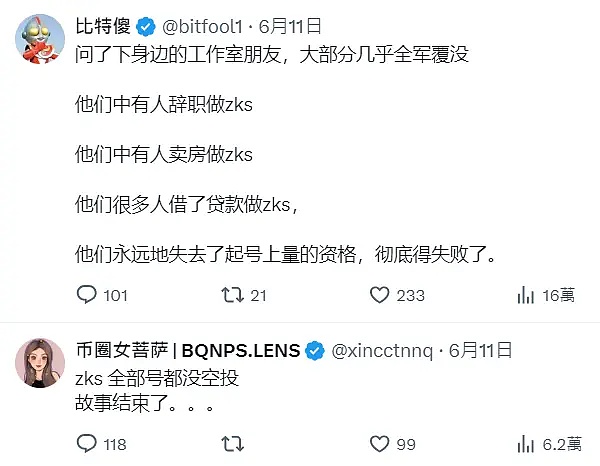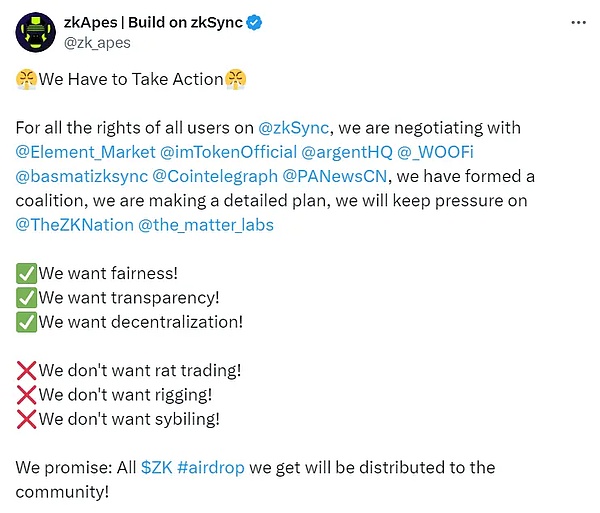Author: Mia, ChainCatcher
The way of interaction between project owners and communities, which the crypto community was once proud of, is now in crisis.
Interaction, on-chain contribution, and airdrops were once the characteristics of the crypto community.
After many airdrop rules, ZKsync has hit this traditional way of interaction that takes into account the trust bond with a statement that "all decisions related to airdrop allocation are made by the ZKsync Association at its sole discretion."
Previously, when facing questions about "airdrops", Taiko's co-founder also claimed: "The rules are not transparent because transparency cannot resolve differences."
Star project owners seem to increasingly regard airdrops as a power to allocate resources - they can be used arrogantly without bearing the consequences, rather than mutual fulfillment between community users and project owners.
We are worried that the spirit of decentralization, transparency and fairness in crypto is fading away.
Only one-tenth of the addresses received airdrops
After the heavy blow of LayerZero's anti-witch shorts last month, the Maoquan has suffered another Waterloo.
On June 11, ZKsync announced that it will conduct airdrops next week and open airdrop inquiries, finally arriving at the answer to its four-year interaction. Official disclosures show that there are 695,000 qualified addresses on the ZKsync chain, accounting for about 10% of the total 6.827 million addresses, which is far lower than the previous TrustGo report predicting a range of 2.05 million to 2.9 million addresses.
According to community statistics, 9,203 addresses received 23.9% of the total airdrops.
After 4 years of waiting, all was in vain. Many users showed their unfortunately annihilated on X.
ZKsync has always been the white moonlight of the "money-grabbing party" because of its celebrity founder and celebrity capital.
A community big V said, "Some people quit their jobs to do ZKs, some sold their houses to do ZKs, and some took out loans to do ZKs. They have lost the qualifications to start an account and increase the volume forever, and have completely failed." It's like a four-year long-distance relationship that was betrayed, "I paid three years' salary and countless late-night warmth", but in return, the goddess ZKS left.
The association decides on airdrops on its own
For conventional airdrops, the core criteria for airdrops are usually the level of activity, duration, and amount of funds in the interaction. The ZKsync airdrop rules have set a total of 7 thresholds:
1. The conditions for the Era mainnet are to interact with 10 non-token smart contracts 2. The Era mainnet has used the payer for at least 5 transactions 3. The Era mainnet has traded 10 ERC 20 tokens 4. DEX and lending protocols tracked on the Era mainnet provide any liquidity 5. Hold at least the Magic Lamp NFT 6. Be active on ZKsync Lite for more than 3 months before the mainnet 7. Donate to Gitcoin through the previous round of ZKsync Lite
ZKsync wrote on the airdrop claim interface, "Meeting one or more of the above airdrop criteria does not mean a legal right or requirement to obtain an airdrop. All decisions related to airdrop allocation are made by the ZKsync Association at its sole discretion."
This statement has aroused dissatisfaction among community users, and many users have raised questions.
A netizen in the crypto community said: "We can understand the strictness of the airdrop rules, but we cannot tolerate the project party's unscrupulous and arbitrary behavior."
This clause completely throws the right to determine the airdrop out of the airdrop criteria. Whether or not to obtain the airdrop seems to depend entirely on the mood of the project party.
In addition, ZKsync also stated that the tokens allocated to addresses that meet the airdrop conditions but have less than 450 tokens will be recycled, which has also caused dissatisfaction among some small users.
"Rat warehouse" storm
Although the time period is long and there are many tasks to participate in, the community users have always had high expectations for ZKsync. If it is a strict rule or some non-traditional practices, it is still within the acceptable range of the community. Recently, a series of puzzling actions taken by ZKsync have aroused more and more doubts and questions from community members.
Nearly 10% of the qualified airdrop addresses mean that most of the token shares are retained in the hands of the project party. Many users have questioned this, believing that ZKsync's move is essentially to reduce market liquidity and secretly hide rat warehouses. In this regard, ZKsync is currently in a state of turning a deaf ear and has not made any positive response to the various questions raised by users.
On the contrary, as the rat warehouse storm escalated, Nansen, who was responsible for ZKsync data review, began to actively distance itself from the matter.
Nansen officially posted on X: "In the spirit of transparency, we want to clarify some misunderstandings about the ZKsync airdrop. We did provide Matter Labs with data on some specific wallet clusters, such as whales or known scammers. However, we did not (help ZKsync) conduct witch reviews, nor did we provide advice on the allocation of airdrops."
In addition, NFT trading platform Element stated on the X platform that as the largest NFT market on ZKsync, the platform did not receive any ZK token airdrops.
All the accusations were directed at ZKsync itself.
Every airdrop is accompanied by some people who are happy and some who are worried, and there are also many who actually win the airdrop. Various screenshots of the airdrop began to circulate on the Internet, as if to prove to the public from the side that "ZKsync's airdrop is fair and effective, but you just don't meet the requirements."
Bankless co-founder David Hoffman also began to speak out and said that according to the survey data obtained in Discord, most people expressed overall satisfaction with the ZKsync airdrop, and also identified the criticism on the X platform as robot speech.
And "ZKsync native project" Zyfi announced on the social platform that it received 1.642 million ZK tokens. This indirectly confirmed the effectiveness of the airdrop.
However, most of the professional Mao Mao Party in the Chinese-speaking area were almost wiped out, and most studios became tools again.

Anti-rat trading
As the number of airdrop addresses dropped sharply and the rat trading storm escalated, the Anti-rat trading alliance came into being.
ZKsync ecosystem NFT project zkApes announced on social platforms that it has formed an alliance with projects such as Element, Argent, and WOOFi. Its goal is to put pressure on ZK Nation and Matter Labs to resist rat trading and other behaviors.

So, will the dual pressure from ecological projects and users force ZKsync to make a new airdrop decision?
The answer is two-sided. If ZKsync accepts the pressure and chooses to reform, it will undoubtedly acquiesce to the existence of rat warehouses; but if it continues to maintain the status quo, the ZKsync ecosystem will most likely lose most of its users and developers.
In the airdrop track, the project party and the Mao Mao party have always been in a game of mutual game, but if the balance of power is tilted to either party, it will endanger the interests of the other party. When the weight is biased towards the project party, the project party can do whatever it wants, and the Mao Mao party becomes a tool.
From the recent Taiko to LayerZero, it is common to criticize the project because the airdrop is not as expected. The transparency of the airdrop rules should be the top priority in the process of project decentralization.
 ZeZheng
ZeZheng





